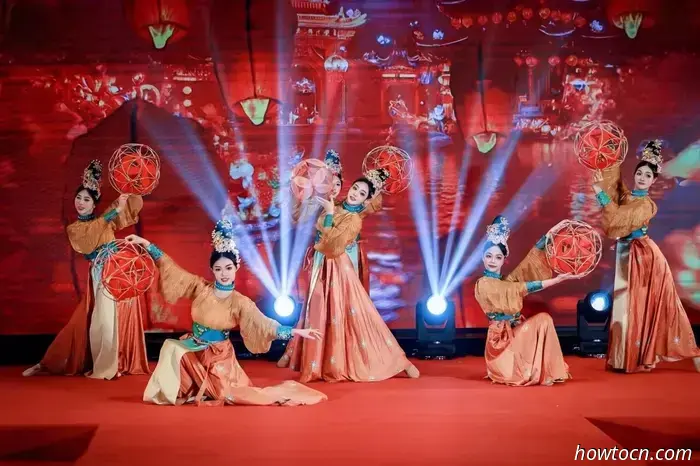
Among the extensive collection of Chinese folk arts, the rolling lantern (滚灯 gǔndēng) stands out as particularly enchanting. Unlike the fixed or suspended lanterns typically associated with festivals, this one is engineered to move, tumble, spin, and soar through the air in the hands of a talented performer while its flame astonishingly stays lit. For centuries, this remarkable art form has traversed the nation, influencing the cultural scenes of Jiangnan, East China, and even the remote northwest, leading to regional adaptations such as the Fengxian rolling lantern, Yuhang rolling lantern, and Haiyan rolling lantern.
The lantern itself is a true testament to craftsmanship. Generally constructed from split bamboo, thin wood, and layers of paper or cloth, its design comprises two concentric spheres: an outer bamboo frame encasing a centrally positioned candle. Cleverly, the structure utilizes a balancing mechanism akin to a gimbal, ensuring that regardless of how the lantern rolls, tumbles, or spins, the flame remains upright, steady, and bright. Accompanied by the sounds of gongs and drums, performers toss, cradle, or twirl the luminous globe, their nimble movements merging human strength with the vibrant spirit of fire.
One of the most ancient traditions is the Fengxian rolling lantern, which boasts a history of over 700 years. Local folklore suggests its beginnings along the flood-prone shores of Hangzhou Bay. To calm the waters and avert calamities, villagers would wear masks of the deity Erlang Shen and perform dances with rolling lanterns as offerings. Over the years, the ritual evolved into a celebratory form of entertainment, and today, at every lantern festival, harvest celebration, or major event, rolling lanterns remain the highlight, revered as the “chief of a hundred lanterns” and the “king among lanterns.” The Fengxian version is particularly intricate, featuring double bamboo spheres and categorized into “civil” and “martial” styles. Its stunning performances have poetic titles like “Wrapping the Waist,” “The White Crane Lays an Egg,” and “Spider Spins Its Silk,” blending daring antics with elegance and artistry.
In Haiyan, the rolling lantern embraces a martial flair. Performers wear short, warrior-like outfits and move in cohesive discipline. With each toss, the lantern soars through the night, its flame unwavering, reflecting both the competitive spirit of athletic skill and the charm of Jiangnan culture. Spectators draw close, fostering a vibrant yet reverent atmosphere as the radiant spheres trace fiery trails across the darkness.
However, rolling lanterns are more than just a visual feast. The art represents a high level of craftsmanship. Lanterns are crafted from meticulously selected mature bamboo, which is split, shaved, and woven with great care. Today, though, you can find DIY rolling lantern kits on Taobao and other shopping platforms if you wish to attempt making one yourself.
There was a period when rolling lanterns experienced a decline due to social changes in the 20th century. They began to resurface during the reform era, first at temple fairs and later on national platforms. In 1999, Yuhang rolling lanterns amazed audiences during the National Day celebrations at Tiananmen Square. In 2008, they shone once again at the opening ceremony of the Beijing Olympics.
In 2023, rolling lanterns illuminated the warm-up performances for the Hangzhou Asian Games, enriched with modern rhythms and choreography. The Linping District even incorporated lantern designs into the Games' mascot styling, providing this ancient art with a contemporary identity on the global stage. Earlier this year, the 798 Art District also featured a rolling lantern show during its Chinese New Year celebrations.
Recently, rolling lanterns have begun to feature in Mid-Autumn festivities, especially in Fengxian, Shanghai, where the tradition is particularly strong. At community events like the Qiutian Yuexia night fair, rolling lanterns kick off the celebrations before families gather to appreciate the moon.
In September 2024, the Shanghai Sports Museum hosted workshops for parents and children to craft smaller rolling lanterns or related ornaments, sustaining the folk tradition through active participation. Various community activities in Fengxian, such as “Welcoming the Mid-Autumn Festival, Warming the Heart,” encourage residents to collaboratively make rolling lantern accessories. These scenes illustrate how an art form once associated with exorcism and harvest ceremonies has been softly reinterpreted as a symbol of reunion and joy. While rolling lanterns may not yet be a common feature of National Day celebrations, their return during Mid-Autumn signifies their ongoing significance in the cycle of Chinese seasonal festivities.






Within the extensive collection of Chinese folk arts, few are as enchanting as the rolling lantern.